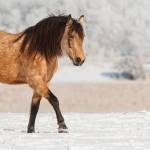Balancing Warmth and Weight Gain in Easy Keepers

In many areas of the world, horses must tolerate low temperatures, sometimes for sustained stretches of time. So long as they remain dry, horses with full winter coats can withstand cold easily, in large part due to the gastrointestinal slogger known as the hindgut, which doggedly turns fiber-rich feedstuffs like hay and haylage into warming energy.
For many horses, the defense against cold is simple: free-choice access to good-quality forage. Is this the best tack for all horses, though, even easy keepers? Unrestricted access to forage sounds like a disaster in the making for horses with sluggish metabolisms and a proclivity for weight gain.
In considering the wintertime diets of easy keepers, mull over these facts:
- As homeotherms, horses maintain a body temperature independent of their surroundings. When their core body temperature changes, horses respond through normal physiologic, metabolic, and behavioral means. During cold spells, for example, horses tend to eat more to rev up metabolic heat production, and they will assume postural changes to minimize heat loss, such as standing against the wind with their tails clamped.
- Cold stress occurs in horses when temperatures fall below the thermoneutral zone, the temperature range in which an increase in metabolic heat production is not required to maintain core body temperature. Low critical temperature, or the lowest temperature of the thermoneutral zone, varies with age, breed, body condition, and climate. For adult horses, low critical temperatures are usually between 5 to 41° F (-15 to 5° C) based on the climate in which they have been adapted.
- Other climatic factors may affect low critical temperature, including rain, sleet, or wind.
“Most normal horses can maintain their body weight during typical winter weather when fed their usual rations, especially if they have access to shelter in windy or wet periods,” said Kathleen Crandell, Ph.D., nutritionist for Kentucky Equine Research (KER). “With this in mind, easy keepers can stay on diets that keep them closest to moderate body condition, particularly when weather conditions are familiar to them.”
When is it appropriate to nudge up the diets of easy keepers?
“Easy keepers are metabolically blessed for cold environments. Remember, most of them fight strenuously against weight loss, and those that are not managed carefully year-round are probably overweight,” Crandell explained. “Long periods of frigid weather can affect body condition over time, even in easy keepers. To prevent this, the reasonable thing to do during cold snaps is to increase the amount of forage they’re fed.”
From a practical standpoint, Crandell recommends boosting forage intake, offering 10-30% more based on the severity of the weather. For example, if a horse was receiving 15 lb (6.8 kg) of hay during typical wintry weather and maintaining body weight, adding 1.5-4.5 lb (0.7-2 kg) during the harshest periods would be sufficient. Continue to monitor body condition weekly or biweekly throughout the winter, being sure to palpate key points to determine fat cover under haircoat, including areas over the ribs and hipbones.
As a final note, horses on all-forage diets—and this would include many easy keepers—should receive vitamins and minerals for overall health. Supplements should include nutrients that have undergone processes to ensure optimal digestion, such as chelation. Options include Micro-Max in the United States and Gold Pellet in Australia, both low-intake pellets that fulfill the vitamin and mineral requirements of horses and ponies on forage-only diets.








